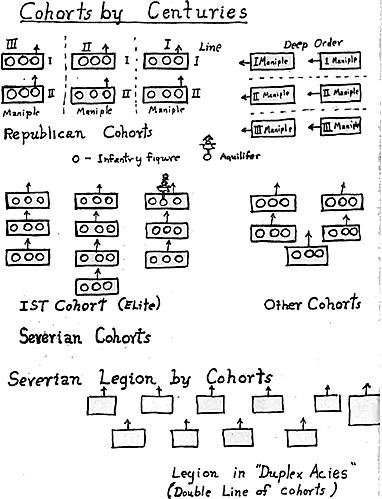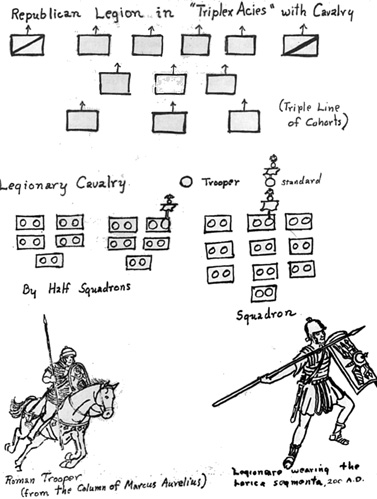In 109 B.C., Jurgatha, King of Numidia, defeated a Roman army and forced it to surrender, even to pass under the yoke of submission. Metellus was sent against the Numidian and he gradually reduced Jurgutha to a more guerrilla warrior in western Numidia. The Roman people, however, were dissatisfied and they elected Caius Marius Consul in 107 B.C. and sent him to Africa with an army. He was successful, and they reelected him Consul in the face of an impending invasion of the Cimbri Tutons and allied tribes, who were ravaging Gaul. Marius swept aside the remnants of the old military class organization, enlisted even the poorest citizens in his legions, standarized legionary organization and equipment, and emphasized drills.
Marius made the cohort, consisting of three maniples, a permanent organization for the first time. As early as P. Scipio Africanual day (230-202 B.C.), the Romans had sometimes formed such organizations by combining one maniple each of hastati, principes, and triarii with a cavalry detachment. Such an informal battle group could operate on a much more independent basis than a maniple. Not until the Marian reforms, however, did the cohort become a permanent feature of legionary organization.
Nominally, the legion retained its old strength of about 4,000 or 5,000 men but in practice they were often understrenght The usual strength of Julius Caesar's legions during his Gallic and Civil War campaigns (59-48 B.C.) seems to have been about 3,600 men. Such legions were divided into ton cohorts (cohortes) of about 360 men each, thirty maniples (manipuli) each around 120 man strong and sixty centunien (centuriae, ordines) of about 60 soldiers each. The hastati, principes and triarii were no longer important as tactical formations. The Equites Romani gradually disappeared as a tactical force. Caesar replaced them with a new cavalry recruited from Gauls and Germans.
Early Emperors
Under the early Emperors, the legion seems to have continued to be nominally about 5,600 man strong. By the reign of Hadrian, (117-138 A.D.) however, the strength of the legion had been raised to 6,000 men. These imperial legions were organized in exactly the same way an formerly, but the strength of the cohorts was increased. The first cohort, the flower of the legion, was composed of a thousand soldiers of the greatest valor and loyalty. This cohort always took the post of honor; the eagle was intrusted to its care. The remaining cohorts were probably 500 men strong. A force of 120 cavalry was attached to the legion (a tes legionis): for administrative purposes they were divided among the centuries, but tactically they seem to have been divided into four troops (turmae) of thirty.
Perhaps by the reign of Septimus Severus (193-211) certainly before that of Aurelian (270-275) the strength of the legion was raised to 6,100 men. The first cohort, now 1,105 men strong, was divided into ten centuries while the remaining cohorts, which were 555 man strong, were divided into five centuries. Each century, in turn, was subdivided into ten conturbinae. There were 726 horse attached to the legion. For administrative purposes 132 troopers were assigned to the first cohort and 66 to each of the other cohorts. Tactically, however, the cavalry was divided into twenty-two turmas, each 33 troopers strong. Aurelian, however, seems to have made the cavalry independent.
Under Hadrian, a now organization was attached to each legion, a numerus of frumentarii. This organization performed duties contact with the grain supply at first; later they operated a postal service for converting imperial orders, served an a spy network and military police corps.
During the Empire, each governor had a bodyguard of infantry (pedites singulares) as well as a horns guard (equites singulares). A corps of veterans. (missici), serving under the vexillium, a type of standard was attached to the legion during the Augustan period. During the second and third centuries A.D. the legion gradually became more and more an administrative unit and less and less a tactical command. Increasingly, wars were carried on by legionary detachments (vexillationes) which were about 1,000 men strong.
Wargaming the Imperial Army
The war gamer who wants to organize a Roman war game army will find that he has a variety of fine figures to choose from. For example, Miniature Figurines, Jack Scruby and Airfix all produce round figures in the smaller scales, and the German flats manufacturers such as Ochel and Heinrechsen also have an ample line of classical figures. Murray, Stadden and others can furnish 50 mm scale legionary figures for collectors whose chief interest might be in uniforms. The economy minded war games buff may well select the Airfix: 20 mm figures which are the least expensive available, although not the best. Although theme figures really represent Second Century auxiliary types, we must remember that not all the newly formed or "promoted" Roman legions were so well equipped as those depirted on the monuments of Trajan and Marcus Aurelius.
One method of organizing a Roman late republican legion in to use three figures on a base to represent a century. Thus 'you can form an entire legion with some 180 figures. Since Airfix boxes come with 18 unable figures each, each will furnish a cohort, plus some other figures - archers, charioteers, etc. -that may be saved to form auxiliary forces. To simplify matters somewhat, I suggest using the standard of the first maniple as the cohort standard and omitting the rest. An Airfix legion could be formed for about $5.00.
The war games enthusiast who would adapt the earlier scheme to the period of Hadrian's rule need only add, say one figure to each century of the first cohort. The attached cavalry could be represented by four bases of two figures each. Since Airfix has no Roman horsemen, your best bet might be to use Miniature Figurines' troopers or Scruby's.
If you want to organize an army for the period after Severus' reign, you should naturally allow for a stronger first cohort. You should have 30 figures if you want your first cohort to be at full strength, 3 figures on each of ten bases. Each of the remaining cohorts would have 15 figures, 3 figures on each of five bases. I would suggest organizing the cavalry in squadrons of twenty.troops,every two troops being represented by a bass with two figures.
BIBLIOGRAPHICAL NOTE
1. G.L. Chessman, The Auxilia of The Roman Imperial Army, Oxford: The Clarendon Press, 1914.
2. H.M.D. Parker, The Roman Legions, Oxford: The Clarendon Press, 1928.
3. Fl. Vegetius Renatus, T.R. Phillip's ed., J. Clark tr. Military Institution of The Romans, Harrisburg, Pa.: Stackpole, Co., 1996L
4. W. Smith, W. Waylte, G.E. Madindin, A Dictionary of Greek and Roman Antiquities, London: John Murray, 1901.


Back to The Armchair General Vol. 1 No. 1 Table of Contents
Back to The Armchair General List of Issues
Back to MagWeb Master Magazine List
© Copyright 1968 by Pat Condray
This article appears in MagWeb (Magazine Web) on the Internet World Wide Web. Other military history articles and gaming articles are available at http://www.magweb.com
